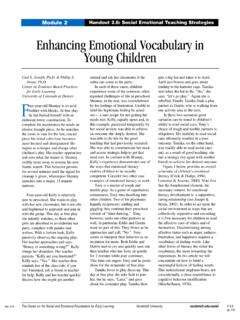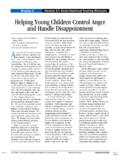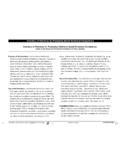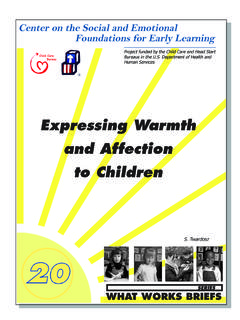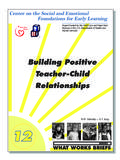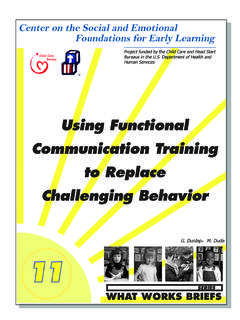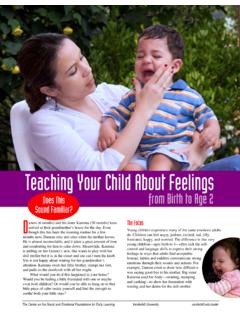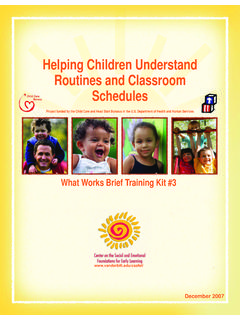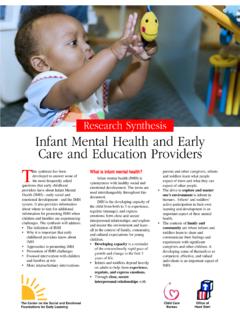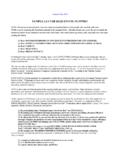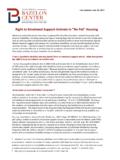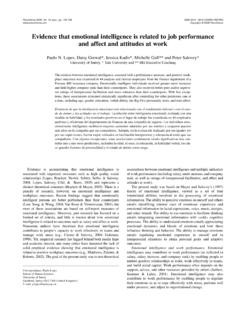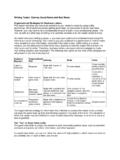Transcription of Responsive Routines, Environments, and Targeted …
1 ,Environments, ,AdministrationforChildrenandFamilies( ). ,nordoesmentionoftradenames,commercialpr oducts, ,KristinTenneyBlackwell,LindseyAllard,an dLisaLucernoOfficeofChildCareOfficeofHea dStartAdministrationforChildren& : Discusswhyitisimportanttopayattentiontot hesocialandemotionalclimateofinfanttoddl ercaresettings. Describetheimportanceofcaregivingroutine sandidentifystrategiesforusingthemtosupp ortsocialemotionaldevelopment. Identifykeywaysinwhichthephysicalenviron mentcanpromotesocialemotionaldevelopment ininfantsandtoddlers. Identifyandimplementtargetedstrategiesto intentionallybuildsocialemotionalskillsi ninfantsandtoddlers.
2 Supportfamiliesinpromotingroutines, * ,ReflectionandActionPlanning30minutes*Tr ainer sNote:Includesstrategiesforsupportingfam iliestopromoteroutines,qualityenvironmen tsandtargetedstrategiestosupportsocialem otionaldevelopmentarewoventhroughoutthet rainingTotalTime6hoursand50minutes**Trai ner !PowerPointSlides!Facilitator sGuide!Chartpaperorwhiteboardandmarkers! Stickynotes!Chartpaper!Markers! (Optional) (Optional) :WhatDoesItMeantoYou? (Optional) (Optional) ! !SettingtheStage:chartpaperandmarkers!Se ttingtheStage(OptionalActivityA) (ChildCareinAmerica) !SocialEmotionalClimateinInfantToddlerCa reSettings(WhatDoesSocialEmotionalClimat eMeantoYou?)
3 ,coloredpaper(yellow,blue,purple,green), glueortape!HighQualitySupportiveEnvironm ents(OptionalActivityC):blankpaper,penso rpencils!HighQualitySupportiveEnvironmen ts(OptionalActivityD): Greetings/goodbyesign:posterboard,marker s,stickers,tape,glue,coloredpaper,scisso rs( ,constructionpaper) Songs:posterboard,markers Lettertofamilies:stationary,pens,pencils orotherwritingtools Listofquestions:paper,pens,pencilsorothe rwritingtools Greetings/goodbyesbook:squaresorscrapsof coloredcardstock,2or3holepunchers,colore dyarn,scissors!HighQualitySupportiveEnvi ronments(OptionalActivityE):blankpaperor stationary,pensorpencils!
4 HighQualitySupportiveEnvironments(Respon siveEnvironments):fullsizecopiesofSlides 32-35(laminated),onesetpergroupofpartici pants!HighQualitySupportiveEnvironments( OptionalActivityF):blankpaper,pensorpenc ils!TargetedStrategiestoBuildSocialEmoti onalSkills(StrategiesforDevelopingEmotio nalLiteracyinInfantsandToddlers) ,onecopyperparticipant.!TargetedStrategi estoBuildSocialEmotionalSkills(UsingBook stoSupportSocialEmotionalLiteracy):Bring asamplingofchildren sbook( ,approximatelyonebookper/2-3participants ) ,UsingBookstoSupportEmotionalLiteracy-ap proximately3copiesperparticipant.!Target edStrategiestoBuildSocialEmotionalSkills (SampleFeelingsBook) ,SampleFeelingsBook,1perparticipant;4-6p airsofscissorspertable,glue,markers.
5 !Wrap-up,ReflectionandActionPlanning(Opt ionalActivityH):chartpaper, (45minutes) (45minutes) ;introduceallspeakers;provideabriefoverv iewofwhoyouare;whereyouarefrom; ,2, , ,list2thingsthatyouhopetosharewithothers duringtoday ,writeonefactorthatcontributedtoyourbein gherefortoday ssession, , , ,summarizetheactivitybymakingthefollowin gpoints: Childcareprofessionalsbringtotheirworkaw ealthofknowledge,skillsandexperiencewhic hcanbesharedtoenhancethecareprovidedtoyo ungchildren. Uniquestrengthsandpositivequalitiescareg iversbringtotheirworkwithfamiliesandyoun gchildrenevolvefrommanythings:temperamen t,familyexperiences,workexperiences,prof essionaldevelopmentandtrainingopportunit ies,communityconnections, : (inaprogram,classroom,orhome)ishowcaregi vers,families, ,but,isnotlimitedto,howchildrenandadults feelaboutthemselvesandtheworktheyaredoin g(whetheritisplaying,teaching,orparentin g);howbehaviorisrecognizedandvalued;howc onflictsareresolved;howchildrenandadults arespokento;howpositivebehaviorsareencou raged;howchildren sneedsarerespondedto.
6 (includingtherelationshipsthatcontribute totheclimate) ,toddlersandadultsfeeltheclimatesupports themandmeetstheirneeds, ,changingadiaper,feedinghim,helpingherto sleep, ,whenachildtriestoclimbonahighchairandis told no , , ,environments, , ( ) ( ,breaks,bathrooms,lunchplans). (suchaschartpaperwith ParkingLot or BurningQuestions writtenatthetop).Also,posta MakingConnectionsLot whereparticipantscanconnecttheideasinthe trainingtootherprofessionaldevelopmentor curricularapproachestheyarefamiliarwith, ,postchartpaperwith : Overview of CSEFEL Infant Toddler Training Module ContentModule 2 The Center on the Social and emotional Foundations for Early LearningVanderbilt One: Social emotional Development within the Context of RelationshipsI.
7 Setting the StageLearner ObjectivesAgendaTraining EnvironmentShared AgreementsWords We UseUnderstanding the CSEFEL PyramidII. Understanding Social emotional DevelopmentWhy Focus on Social emotional Development?CSEFEL Definition of Social emotional DevelopmentABC s of Social emotional DevelopmentKeys to School ReadinessStrategies Caregivers Can Use to Support Social emotional DevelopmentSelf RegulationThe Developing Brain and strategies to Build Brain ConnectionsObservation and Reflection as a StrategiesLearning from FamiliesIII. Understanding Behavior: Making Sense of What You See and HearReading CuesHow do you Respond?
8 Knowing Social emotional MilestonesDevelopmental Challenges and OpportunitiesTemperamentThe Relationship between Social emotional Development and BehaviorThe Basics of BehaviorSocial emotional Development and Values, Beliefs and AssumptionsExamining Our emotional ReactionsStrategies for Responding to FeelingsCultural InfluencesIII. Forming and Sustaining Relationships with Young Children and FamiliesWhat are Relationships? strategies to Build Relationships with Young ChildrenAttachment RelationshipsStrategies to Build Relationships with FamiliesIV. Nurturing and Supporting the Social and emotional Development of Infants Toddlers and TheirFamiliesUnderstanding FamiliesRisk Factors Affecting FamiliesMaternal DepressionStrategies to Respond to Maternal DepressionWorking with FamiliesV.
9 Essential Positive MessagesVI. Major Take Home Powerpoint HandoutsModule 2 The Center on the Social and emotional Foundations for Early LearningVanderbilt whereparticipantscansharefavoritesongs,g ames,activities, (thatconnecttothemodulematerial). : Arethereideasorrequeststhatyoumightwantt oaskofyourcolleaguestomakethetrainingenv ironmenteffectiveandconducivetolearning? or Ifparticipantsdon thavesuggestions, sNote:Youmaywanttosharewiththegroupthaty ouarechoosingtousetheterm sharedagreements insteadof groundrules. Sharedagreements ismeanttoreflectagreementsmadebythegroup ratherthan rules , rules rulesaremadetobebroken.
10 Oncethegroupdeterminesthesharedagreement s, (sometimesreferredtoasgroundrules) ,learning, ,sharingandagreementofexpectationshelpsc ontributetothedevelopmentofasafe, TeachingandSupporting:Thesignificantrole oftheadultcaregiverisreferenceddifferent lynationwide-teachers,careteachers,early learningcaregivers,earlychildhoodprofess ional, teaching or supporting, ,responsiverelationships( ,waysinfantsandtoddlersarecaredfor,readi ngcues,meetingtheirneeds,etc.).Ascaregiv ersdeveloprelationshipswithchildrenandfa miliesandobserveandthinkaboutwhattheysee andhear,theycanplanforanddesignexperienc esthatcontributetoachild teachingandsupporting wealsomeanindividualizedapproachesthat meet theyoungchildwhereheorsheisdevelopmental ly.
